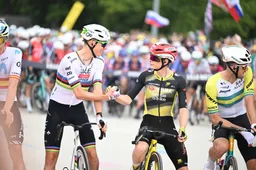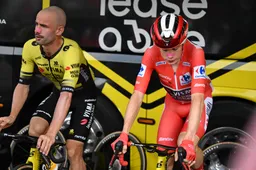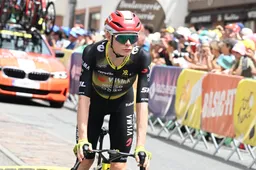IDL Retro | The Col de la Bonette: Alpine giant that destroyed the aspirations of a young rider
CyclingThursday, 30 November 2023 at 13:22

About a month ago, it became clear that one of the most impressive climbs in cycling history is making a return to the Tour de France. The Col de la Bonette, which hasn't been featured since 2008, will be the main course in the nineteenth stage of the 2024 Tour. Midway through the ride to Isola 2000, the riders will nearly reach heaven (or hell), attaining the highest pass road in Europe at an altitude of 2802 meters. In this IDL Retro, we look back at the story of the Alpine giant and its conquerors, from Federico Bahamontes to the lesser-known John-Lee Augustyn.
The Col de la Bonette as the fighting ground for Pogacar, Vingegaard, Roglic, and Evenepoel in the hunt for the yellow jersey?
There's a high chance that the Col de la Bonette will play a key role in the battle for the yellow jersey next summer. The Tour starts somewhat slowly in terms of climbing. The peloton must conquer the Col du Galibier on day four and face a tough Pyrenees duo in week two, but these stages don't seem hard enough to create significant time gaps. The fact that the Bonette, a monstrous climb due to its length, steepness, and especially altitude, is positioned in the final weekend, makes it an ideal spot for a decisive attack. Moreover, we are dealing with a generation of classification leaders who aren't afraid to fire early.
Actually, the Bonette is a bit higher than 2700 meters. But the small detour, which is also used in the Tour de France, leads to the hundred meters higher Cime de la Bonette. The road here seems drawn with a pencil line in the landscape. Riders pass a ravine, over a thin edge around the Cime. This creates breathtaking images. The altitude results in a barren, dark gray rocky landscape. This makes the Bonette one of the most desolate places the Tour can visit, and also one of the most beautiful. Miles before the summit, the views are breathtakingly beautiful. The climb is never really very steep but is mostly long and exhausting."
"The Bonette, unlike other literally breathtaking giants such as the Col du Galibier, the Col de l'Iseran, and the Col d'Izoard, has not been used often in the Tour. It has only been included in a stage four times. In the 1960s, one of the greatest climbers of all time, Federico Bahamontes, was the first to reach the summit of the Alpine giant twice. In 1959, Bahamontes won the Tour, and he secured the mountain classification six times. Thus, in its first two passages, the Bonette had a more than suitable winner. The last rider to round the summit first on the Alpine giant was an unknown, unsuspecting South African.

Federico Bahamontes, nicknamed "The Eagle of Toledo," conquered the Bonette twice.
There was Augustyn, while Evans, Sastre, and the Schleck brothers zoomed past
Team Barloworld was a remarkable wildcard team in the 2007 Tour. The team, clad in red, included a very young Geraint Thomas among others and won a sprinters' stage with Robbie Hunter. However, it was the eccentric Colombian Juan Mauricio Soler who stole the show. He finished tenth in the overall classification, won a mountain stage, and took the polka dot jersey. In 2008, the team wanted to put everything on Soler again. However, the leader had to drop out early, so other freeriders had to step out of the shadows. Among them was the 21-year-old South African John-Lee Augustyn, the second-youngest participant in this Tour. He slipped into the breakaway in the sixteenth stage, finishing in Jausiers.
After the equally long Col de la Lombarde, the breakaway group ascended the Bonette. The pace slowed due to the altitude. Riders gasped for oxygen. With a strong attack, significant gaps could be made in just a few hundred meters. Augustyn surveyed his fellow escapees and decided to make a move, seeking a moment of eternal fame in the world's greatest race. Established climbers like Cyril Dessel and Tadej Valjavec couldn't follow him. Thus, the young Augustyn reached the roof of the Tour first. However, he still had to descend to Jausiers. And it's in that descent where things went completely wrong.

John-Lee Augustyn, just before his terrifying crash on the descent of the Bonette
The descent is full of treacherous turns, and in one of the first, Augustyn goes straight instead of turning right. He plunges into the ravine. Fortunately, the abyss is less steep than feared, and with the help of a spectator, the overwhelmed South African climbs back up to the road. It results in unique footage of a helpless rider, confused by the crash he just experienced. And there's a problem. Augustyn's bike has taken a nosedive further down the ravine and lies dozens of meters away. He has no choice but to wait, nearly three kilometers high, for the team car. Meanwhile, the leaders of that Tour, Cadel Evans, Carlos Sastre, and the Schleck brothers, rush past the bewildered youngster.
Augustyn has to wait over five minutes for a new bike. Shaken and with the thought of a vanished stage victory, he eventually crosses the line in 33rd place. A dream poorer, but a near-death experience richer. The bizarre climb and descent of the Col de la Bonette also mark the last impressions of the young South African for the general public. His career, one without highlights, fades in 2014 after a long injury. Augustyn remains one of the successful masters of Europe's highest pass road. But it's mainly the images of the descent that are etched in the memory of many followers.
Undoubtedly, the long climb next summer in the grueling mountain stage to Isola 2000 will lead to a major attrition battle. Perhaps the Bonette will be the arena for a unique fight between Tadej Pogacar, Jonas Vingegaard, Primoz Roglic, and Remco Evenepoel in the battle for the yellow jersey. Let's hope the main characters of next summer fare better than John-Lee Augustyn. After all, whoever climbs the Bonette must also descend..."
<i>Bekijk hier de beelden van de val van Augustyn, vanaf 8:55</i>
IDL-productions

95 (or was it 97?) wins and a new record year, but losing that one race still hurts UAE Team Emirates - XRG

Former cyclocross world champion recalls wonderful memories of young Nys: "Back then we thought: that's not going to work out"

There was smoke so there was fire, but in 2026, how will Lidl-Trek make sure that fire doesn't flare up again?

Why Pogacar’s Strade Bianche crash and Pidcock-chase still feels like a miracle in Tuscany

Does the grand Tour succes outweigh the spring struggles? Visma | Lease a Bike had another rollercoaster season
Latest Cycling News

Niermann reveals philosophy behind Visma transfers for 2026 and sees 'possible new superstar' in own ranks

Tadej Pogacar forced to say goodbye to confidant after 6 years at UAE Emirates-XRG

Top talent Paul Seixas opts for balanced program in first months of 2026, French media already starting to salivate

Red Bull-BORA-hansgrohe completes squad by bringing in Belgian sprinter and victim of merger

Does Van Aert think he can still win the Tour of Flanders? 'Maybe only three riders in the world can still believe it'
Popular Cycling News

🎥 Wout van Aert takes us on a journey over the cobbles of Roubaix - all thanks to an amazing pair of glasses

🎥 Evenepoel hops on the 'Calpe Express', as Van der Poel makes his Belgian companion suffer once again

Campenaerts received wonderful compliment from Vingegaard and refutes Visma reproach: "You put your balls on the table"

Giro director tries to seduce Vingegaard with very direct comment: "I would not miss the opportunity"

Red Bull-BORA-hansgrohe completes squad by bringing in Belgian sprinter and victim of merger
Latest Comments
- Pidcock could follow everyone but Pogi while finishing 3rd. No second place rider this season😃Veganpotter16-11-2025
- Now the Palestinian protestors can stop their whining. Trump came to the rescue. So they can now STFU and go back to waving the rainbow flags.raufus15-10-2025
- Cracked the code lol. If it was that easy to 'crack the code' jonny Vegas would be charging up the Kwaremont giving Pog a dose of his medicine. Evenepoel can't match pog on a climb and neither can mvdp. Anything with a half difficult climb and Pog smashes the field. Even on flat(ish)parcours like Roubaix it came down to a mistake and crash by pog to definitively crown mvdp. MSR is the only one that Pog probably won't win.kevpt10-10-2025
- We've seen this movie before. I think Pogacar is doping.DeadBlow10-10-2025
- 👍Bea08-10-2025
- 👌🏻Bea08-10-2025
- What the data doesn't show is how much of an effect drafting had for evenepoel. Pogacar went with del toro at 100km whilst Evenepoel was still in the bunch. Despite the bike changes he still had a lot of assistance getting back to the bunch. Pogacar then rode 60km solo whilst evenepoel rode with Healy/Skjelmose until going solo in thd last 10-15km. Thats ~20% less power / energy requirements for 45-50km. Apples and oranges...kevpt30-09-2025
- 👏👏Bea24-09-2025
- Agreed! As we all know now, Juan Ayuso will be on another team. But it was sweet to see him win the stages at La Vuelta. I do love the drama of cycling admittedly but its clear to see the talent of winners of stages in a Grand Tourryhw2814fq921-09-2025
- Pogacar has no competition he has won everything, I cant imagine even being him in that position!! Crazy. I am sure he has some back up plan for how he wants to spend his retirement years at age 30 onward. Does he like beer? Plenty of innovation in brewing. And you don't have to be super social. Chapeau/Cheers whatever you like Tadej you will do.ryhw2814fq921-09-2025
Loading